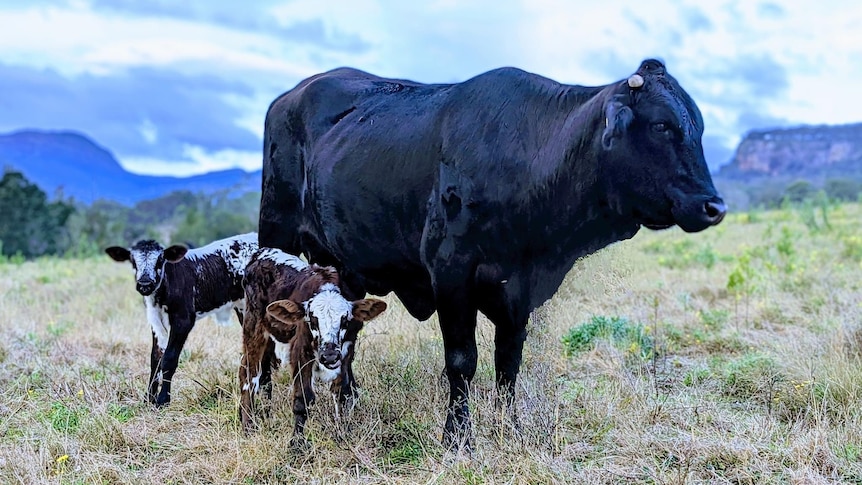It may be a bumper season for many Queensland cattle breeders due to good rains, but one farm has seen an increase in twins as well.
Key points:
- A south-east Queensland grazier finds two sets of twin calves within the space of a week
- A leading veterinarian says the chance of beef cattle having multiple births is less than 1 per cent
- Producing twin calves puts extra pressure on their mother to produce enough milk
Grazier Sue Harrison said she was shocked to find two of her breeders had given birth to twins over the past week on her Darlington property in the state’s south-east.
“I go around and check the cows because they are all calving at the moment,” she said.
“I saw this cow laying in the grass, which is quite long, and I saw one calf pop up to have a drink, and I looked and had to do a double take, because there was another one on the other side.
“It was a bit of a surprise.”
Three days later Ms Harrison was checking the stock again and saw another cow had given birth to twins.
The sixth generation grazier said they had previously only ever seen one set of twins.
“One of the calves was born backwards so we lost him,” Ms Harrison said.
Both twins were conceived naturally from Brangus mothers and Speckle Park bulls.
A rare event
University of Queensland veterinarian Ben Wood said the chance of beef cattle having multiple births was less than 1 per cent.
“It’s in that half a per cent [range] for those beef cows, so if they’ve got 100 breeders, they’re going to get that one every two or three years,” he said.
“Two sets is an even rarer chance.
“I bet those cows are really doing quite well, so that will increase their chance of ovulating twice at the same time, so it increases their fertility.”
Dr Wood said it had been a “particularly good season” for Queensland graziers due to a lot of rain producing good grass.
But he said twin calves put a huge strain on their mother, who had to produce large quantities of milk.
“That cow, the following season, probably has less of a chance of getting in calf because raising twins takes a lot out,” he said.
Sue Harrison said they were supplementing the two mothers’ diet with lucerne hay.
“Both calves were having a drink so we’ve just got to hope that each of them gets enough to drink,” she said.
“Being winter when there’s not much green feed for them, it’s a bit hard for them to make up the extra milk.”
fertility problems
Dr Wood said twin calves of a different sex could struggle to reproduce.
“If they are sharing that placenta and they are a different sex, then the sharing of those hormones, that testosterone … that has a big effect on that female calf,” he said.
“They’ll have smaller ovaries and their reproductive tract just won’t develop.
“The male calf will be a little bit less reproductively fit, but not to the same extent as the female.”
The veterinarian said dairy cows were more likely to give birth to twins.
“Typically a dairy cow will have more twins on average,” Dr Wood said.
“They’re in that 2 to 4 per cent range.”
Dr Wood said cows could have difficulty delivering twin calves naturally because their legs could become tangled during birthing.
.
